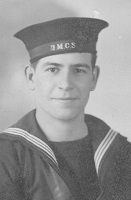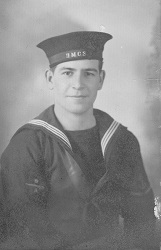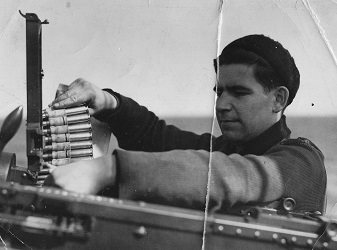|
In memory of those who have Crossed the Bar
Citation for Mentioned in Despatches:
"During the sinking of HMCS Windflower, in spite of recurring disasters and surrounded by explosions and escaping live steam, Leading Seaman Charrier exhibited steadiness and coolness. His conduct throughout was marked by outstanding courage. For bravery, resource and devotion to duty."
Georges Charrier's entry in The Memory Project: I thought that I would be gone for eight years. So everyone said to me, ''Farewell, Georges!'' We didn't know what was going to happen during the war. But I wasn't worried, I signed up. I arrived the next day [the day after enlisting], the 5th [of June, 1938] and they got us set up, there were quite a number of us. The navy had started to mobilize its workforce and they hired about sixty people. There were sixty or so of us newly hired people. They put me on a ship, a destroyer; the first was the [HMCS] Skeena. But it was only temporary because they were still figuring out where to send us, they weren't sure. They were nervous because they knew that the war was imminent. After that, I was transferred to the [HMCS] Saguenay. I was only on the Skeena for about a month, and then after that I was on the Saguenay. On the Saguenay, I think they knew that there would be a war, because the King and Queen came to Canada, George VI. We went to meet them halfway, in the middle of the Atlantic, and then we took them to New York, to New York for the World’s Fair in 1939, before the war. Afterwards, we went back to meet the French ships that were transporting gold that had been sent from London to France then on to the United States for safekeeping in Fort Knox [at the United States Bullion Depository]. We escorted the ships to the United States. We met them halfway, the French [ships]. We transported that – the war was getting closer, so they made sure the gold was safe. Then the war started. We transported soldiers to the coast of Labrador to protect the coastline and to prevent submarines from submersing to the ocean floor. Afterwards, they had us escorting convoys. That's what we did; escorted convoys that were transporting weaponry equipment to Europe. I participated in the Battle of the Atlantic. I started out on the Saguenay but wasn’t there for long, since they reorganized the workforce again. They were having problems with the workforce. They didn't have enough people. They needed people with experience and with some knowledge, which is what I had. Then I was transferred to the Ottawa, the HMCS Ottawa, which was a British ship that had served in the Indian Ocean with the British Navy. We managed to sink a submarine, it was an Italian submarine. Our provisions were used- we rescue survivors, there were a lot of survivors. And we did that often; when ships had sunk at sea or when there were ships, sometimes we couldn’t always protect the whole convoy because there were a lot of submarines. The longer the war went on, the more submarines there were. And then we lost ships because there weren't enough of us to protect them. And couldn't go any faster because the convoy could only go as fast as the slowest ship. The older ships go only go seven, eight knots per hour, while we could travel up to 35 knots an hour. Then we had an accident [on December 7, 1941]. There was fog and ice. It was a convoy with probably a hundred ships. We couldn't see anything. A cargo ship snagged us, hit us. It collided with us. It cut the back of the ship, the [HMCS] Windflower. We lost our depth charges but they didn't explode, as far I know. There was an explosion later on, but I believe it was the boilers that blew up. We lost 26 men. I don't think that I'll tell you that entire story. A report was written about it, it's in Ottawa. There was an investigation in Newfoundland. One of my former captains, Captain Mainguy, was in charge of the investigation. The entire ordeal, everything that happened, was documented. After that, the ship that hit us, I can't remember the name but I noted the details, I'll get them out later, they came to get us, to pick up our survivors. Of course, they picked me up, too. They took us to Newfoundland, to St. John's, Newfoundland. We underwent a brief medical exam. I was fine. I was just cold since we had spent a couple of hours in the icy water. It was good they came to get us when they did since some of us didn't make it in the cold water. After the medical exam, they gave us new uniforms since we didn't have our clothes anymore and then we went on leave. They let us take leave for 30 days. I went back home for the 30 days. When I arrived in Montreal, there were reporters waiting for us, there were a lot of journalists.
Ships served in: HMCS WINDFLOWER - Survived the sinking of HMCS Windflower
(1) Georges Charrier - 1940 (2) Georges Charrier on HMCS OTTAWA - 1942 Source: The Memory Project
|



